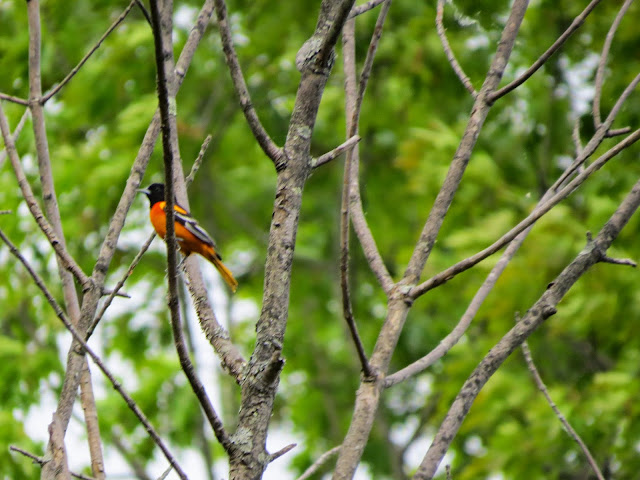Eastern Kingbird
a very distant shot of the Kingbird on the nest
Orchard Oriole
Our next stop was in Sutton, where we wandered a large field in search of a Grasshopper Sparrow, among other things. The first thing we saw, that was an unexpected surprise for all of us, was an Eastern Meadowlark. This was a life bird for me! I would have like to have gone in for a closer view, but I'll have to safe that for another day.
Eastern Meadowlark
Field Sparrow
Prairie Warbler
The sun came out and the temperature rose and soon butterflies were tempting my eyes away from the birds.
American Copper
Eastern Tailed-Blue
These beautiful flowers from the pea family were lining the road.
Back up to Millbury we went to end our field trip with a walk at Brierly Pond Conservation Area. The parking lot was a hotspot at this location, yielding Chestnut-Sided Warbler, Black-and-White Warbler, and Pileated Woodpecker!
Other highlights from the walk included:
Rose-Breasted Grosbeak
Juvenal's Duskywing
Sarsaparilla
Wild Geranium
Eastern Tiger Swallowtail
Cherry
Golden Alexander
Chestnut-Sided Warbler
After lunch, I stopped briefly at Lake Chauncy in Westboro. I thought I saw a baby Killdeer, but they turned out to all be adults. I did find a Least Sandpiper, though, which was so tiny and cute! You can't really tell its size from the photos, but it was about 1/3 the size of a Killdeer.
Least Sandpiper
again, closer
Celandine
I don't know what this flower is, but it is a pretty one! Hope it's not invasive!
American Robin sitting on nest
American Redstart (male)
American Redstart (female)
Baltimore Oriole
Black Aronia
Northern Water Snake
I'm so glad I wasn't looking high in the treetops when I walked in this part of the trail! This water snake was huge and right in the path. Why was he so far from the water????
So much variety today! In spite of the weather, it was a great day. I only wish there had been better light for photos!





























Dawn: I think the unknown plant under Celandine is called Black Jetbead (Rhodotypos scandens). Year ago, when I lived in Massachusetts and first noticed this shrub, I was stumped for some time. It turns out it is an introduced species originally from east Asia. Look for black fruit to follow the flowers.
ReplyDelete